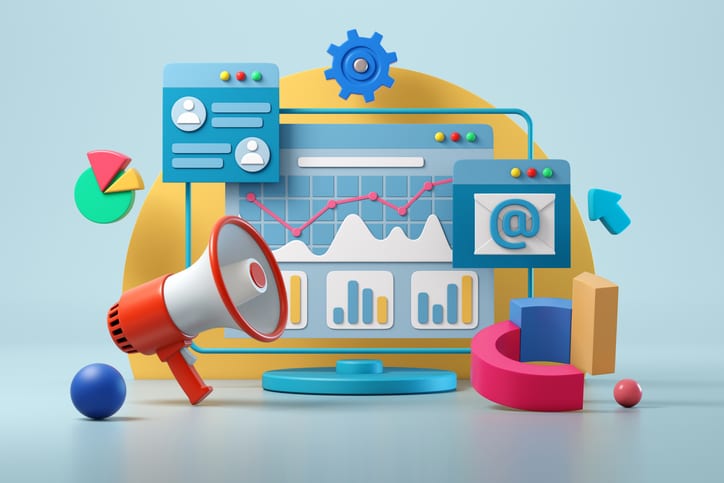Traditional Marketing vs. Digital Marketing
By Paul Bobnak | March 10, 2021

Editor’s Note: This post was originally published in March 2021 and has been updated for accuracy and comprehensiveness as of June 2023.
When you’re planning a campaign for a product or service, you may think that you’ll have to choose a side in the traditional marketing vs. digital marketing argument. But there’s just one problem:
You don’t – because it’s a false choice.
People buy for four reasons:
- Price
- Service
- Exclusivity
- Quality
How you communicate to customers and prospects will vary depending on your target audience, budget, time, and other factors. In some cases, either traditional or digital may work best at producing that all-important return on investment (ROI) that you desire.
On the other hand, some campaigns may work best when they incorporate both.
So how do you know which one to use?
To help figure it all out, a good place to start is understanding the difference between traditional marketing vs. digital marketing.
What’s the difference between Traditional Marketing vs. Digital Marketing?
The biggest difference between traditional marketing and digital marketing is the medium used by the marketer to communicate a message. Traditional marketing relies on analog channels like print. Digital marketing relies on an internet-connected electronic device to deliver a message.
What is Traditional Marketing?
Traditional marketing is an activity that promotes goods and services using a channel originating long before the rise of online communications in the late 20th century.
It’s a broad term that includes many tactics, such as:
- Direct Mail
- Signs
- Broadcast Radio & TV
- Phone
- Face-to-Face Meetings & Events
Why Use Traditional Marketing?
Traditional marketing works well today based on hundreds of years of experience.
Thanks to its longevity, each form of marketing enjoys a wide variety of applications for marketers to consider in a marketing campaign.
- Reaching large broad audiences quickly is ideal for brand awareness
- Appealing to senses (sight, sound, touch, smell) with a wide variety of tangible materials and experiences
- Some segmentation and personalization of marketing efforts
- Personal interaction with customers and prospects
- Longer & more memorable message recall with tactile engagement
- Less message clutter and more differentiation compared to digital
What is Digital Marketing?
Digital marketing is any effort that markets products or services on a connected electronic device. It didn’t exist until 35 to 40 years ago. And many of its channels date only from the last 15 years.
Digital marketing includes many online marketing techniques, such as:
- Email Marketing
- Text/SMS
- Video
- Websites
- Popups
- Pay-Per-Click Ads
- SEO
- Apps
- Podcasts
- Social Media Marketing
- Automated/programmatic marketing
- Content Marketing
Why Use Digital Marketing?
The nature of the channel you use (and the device it’s designed for) determines the quality of your message, and more importantly, how well you can target very specific types of people to achieve your marketing goals.
Digital marketing strategies help marketers achieve a wide variety of important goals.
- Lower costs for scaling campaigns
- Ease of measuring results based on data
- Real-time results and customer tracking allows precise targeting
- Simple, near-instant changes to strategy, pricing, and other elements
- Highly specific targeting of audiences
- Faster two-way interaction with audiences and individuals to build loyalty
Pros & Cons of Traditional Marketing
Pros of traditional marketing have been well-known for many years and include:
- Familiarity by both marketers and audiences
- Ability to reach large, broad audiences easily in more places
- Wide variety of physical, tangible experiences possible because of appeals to senses (sight, sound, touch, smell)
- Segmentation and personalization work several channels
- Less message clutter compared to digital
Cons of traditional marketing are sometimes cited, due to the limitations of some of the channels and include:
- Less two-way audience interaction (depending on the channel)
- More difficult to measure reach and attribution for messaging (depending on the channel)
- Longer lead time usually needed to plan and execute campaigns, as well as make changes based on testing and results
- Expertise in some channels and methods is less widespread than in the past
Pros & Cons of Digital Marketing
Pros of digital marketing are apparent as some technologies mature and others are introduced and deployed by marketers. They include:
- 1-to-1 personalization
- Lower costs
- Real-time response tracking
- Adaptability to a wide variety of platforms and devices
Cons of digital marketing have also become more apparent as audiences mature and marketers adjust
- Digital fatigue as consumers are overwhelmed with messages & platforms
- Competition continues to grow
- Privacy and data security concerns
- Ad blockers limit reach to internet users
- Attribution often limited or not precise
- Technologies depend on power and internet access
Traditional & Digital Marketing FAQs
Which is more effective, digital marketing or traditional marketing?
The answer is a little complicated. It all depends on what is best for first, reaching your audience, then, turning them into customers, as well as continually delighting them. That’s made easier when you provide unique, important, and meaningful help and value.
Will digital marketing replace traditional marketing?
No, digital marketing will not entirely replace traditional marketing. Instead, both forms of marketing are evolving to coexist in the marketplace. When both are available, they offer marketers a full range of options for their marketing campaigns, limited only by budgets, deadlines, and other factors that help marketers decide what methods or combinations work best to meet their goals.
Is digital marketing cheaper than traditional marketing?
Some people claim that digital marketing is cheaper than traditional marketing. However, considering all of the factors that can affect the cost of a campaign run in a single channel – any channel – it’s impossible to say which method of marketing is cheaper.
How has digital marketing changed traditional marketing?
Digital marketing has changed traditional marketing in some important ways. A big emphasis on data, always a strong point of some traditional marketing channels like mail, has been taken several levels higher thanks to new technologies and tools. Additionally, marketers in some traditional channels – again, such as mail – focus on cost-effective strategies like segmentation and personalization.
There’s a lot you can do to make the most of traditional marketing while not being stuck in the past. For example, in direct mail, these methods mirror concepts from the digital world:
Wrapping it up
The benefits of traditional marketing methods such as direct mail – as noted above – are many and well-understood. It’s one of many reasons mailing.com has grown and thrived for over 50 years.
We know the difference between traditional marketing and digital marketing. Looking for a direct mail marketing partner that can help you build a unified customer experience? Contact our team today!


